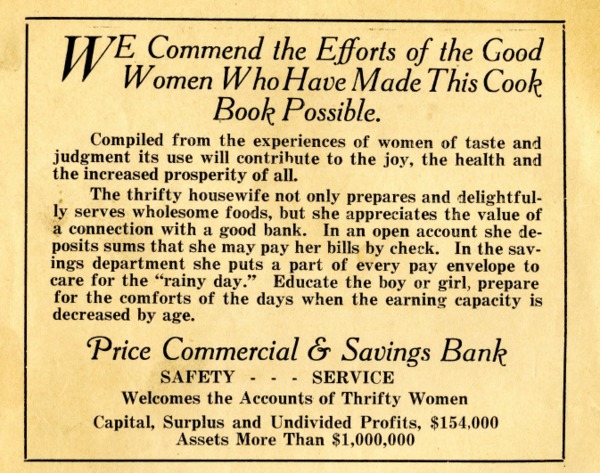Dublin Core
Title
Description
Today, home cooks can simply search the internet to find thousands of recipes for foods from all over the world. But sharing recipes and creating community around cooking is nothing new. For many Utah women, their local church congregation was a bastion of meal inspiration. Throughout the early 1900s, women would share recipes and create community cookbooks, sometimes selling them to raise money for charities or local activities. But, more than just a list of recipes, these books connected rural communities through food.
Community cookbooks can be found throughout Utah, and are often tied to Latter-day Saint church wards. Women donated their tried-and-true recipes and volunteers typed up the cooking directions -- no small task in the days before word processors! The ingredients were often simple and inexpensive, dictated by the region and year that the book was completed. Rations, food shortages, and crop yield all impacted the types of meals that women would cook for their families. Recipes came from mothers, sisters, and friends, and are credited with the name of the cook. Of course, no matter the ward or decade that the cookbook was published, some recipes -- such as Jell-o salads and funeral potatoes -- show up time and time again.
Some cookbooks, like the Carbon County Community Cookbook, printed in the 1920s contained more than just recipes. They included advertisements that targeted the female shopper. Ads for local grocery stores promised to supply home cooks with “anything you need for any recipe in this book.” Other advertisements appealed to the women who contributed their recipes and time to make the book, using flattery to sell their products.
These cookbooks, written for and distributed by women, preserved a food culture that is often dismissed as "women's work." Recipes connected communities through food and were influenced by everything from regional foods to popular nutritional advice. Community cookbooks were produced in rural and urban areas alike and they served an important role in connecting Utahns to both their food and their local community. Unlike today, where recipes are pulled from across the world, these books were grounded locally and served even the smallest community or church ward.
Creator
Source
_______________
See Hannah Seariac, “A Brief History of Latter-day Saint Women’s Cookbooks,” Deseret News, June 9, 2022; James M. Hill and Richard L. Popp, “Toward a Mormon Cuisine: A Light-Hearted Enquiry into the Cultural Significance of Food,” Sunstone Magazine, 12:3, no. 65 (May 1988); Carbon County Community Cookbook, c. 1920; Miriam B. Murphy, A History of Wayne County,Utah State Historical Society, 1999; Jessica Stoller-Conrad, “Long Before Social Networking, Community Cookbooks Ruled the Stove, NPR, July 20, 2012; Janet Peterson, “Those Old Favorite Relief Society Recipes,” Meridian Magazine, September 15, 2004; Kate Holbrook, “Religion in a Recipe,” Journal of Mormon History, 38, no. 2 (Spring 2012); Kate Holbrook, “Intensifying Taste, Intensifying Identity: Collectivity through Community Cookbooks,” Signs 37, no. 3 (Spring 2012).

